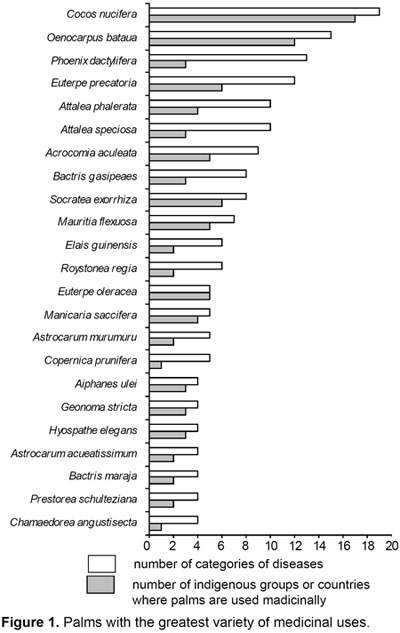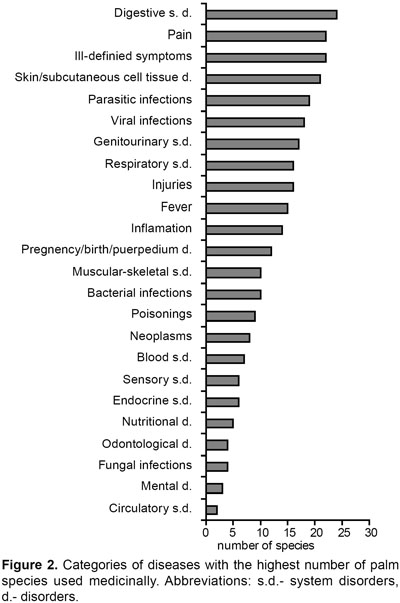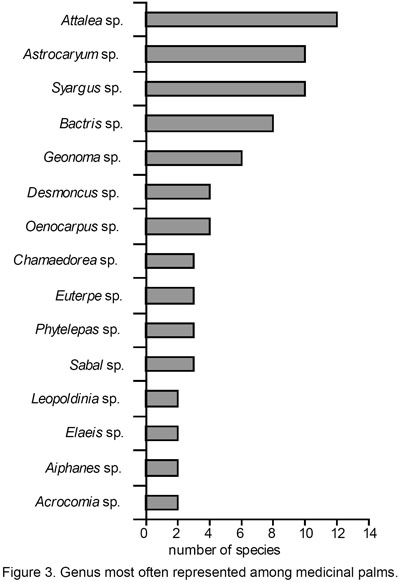Servicios Personalizados
Revista
Articulo
Indicadores
-
 Citado por SciELO
Citado por SciELO
Links relacionados
-
 Similares en
SciELO
Similares en
SciELO  uBio
uBio
Compartir
Revista Peruana de Biología
versión On-line ISSN 1727-9933
Rev. peru biol. v.15 supl.1 Lima nov. 2008
TRABAJOS ORIGINALES
American palms used for medicine, in the ethnobotanical and pharmacological publications
Las palmeras americanas con uso medicinal en las publicaciones etnobotánicas y farmacológicas
Joanna Sosnowska1 and Henrik Balslev2
1 W. Szafer Institute of Botany, Polish Academy of Sciences, Lubicz 46, 31-512 Krakow, Poland. Email: j.sosnowska@botany.pl
2 Department of Biological Sciences, Aarhus University, Build. 1540, Ny Munkegade, 8000 Aarhus C., Denmark. Email: henrik.balslev@biology.au.dk
Trabajo presentado al Simposio Internacional Las palmeras en el marco de la investigación para el desarrollo en América del Sur, del 07 al 09 de Noviembre 2007, Museo de Historia Natural, Universidad Nacional Mayor de San Marcos, Lima, Perú.
Abstract
The center of diversity of palms (Arecaceae) in tropical America is found in the Amazon basin and along the Panamanian isthmus.The greatest palm species richness has been reported for the Iquitos and Chocó areas. Many species of palms are used mainly for construction and due to their edible fruits. In addition, there are 104 palm species that are used for medicinal purposes in many regions of the Americas. Cocos nucifera and Oenocarpus bataua are the most commonly used species for medicinal purposes. The fruit is the most commonly used part of palms for medicinal purposes (57 species). The traditional and medicinal use of plants has deep roots in indigenous communities of Latin America. The significance of ethnomedicine for health care of local populations can not be ignored anymore because it plays a significant role in basic health care in developing countries. Interdisciplinary research in antropology, ethnobotany and ethnopharmacology helps gather information on ethnomedicine and design new drugs for modern medicine. American palms are sources of useful bioactive compounds against diabetes, prostate hyperplasia and leishmaniasis.
Keywords: palms, Arecaceae, medicinal plants, ethnobotany, America.
Resumen
El centro de la diversidad de palmeras (Arecaceae) en América tropical se encuentra en la cuenca del Amazonas y a lo largo del istmo de Panamá. La mayor riqueza de especies de palmeras ha sido registrada para las áreas de Iquitos y de Chocó. Numerosas especies de palmeras son útiles, principalmente en la construcción y por sus frutos comestibles. Adicionalmente, 104 especies de palmeras neotropicales han sido reportadas con aplicaciones medicinales en muchas regiones de América. Cocos nucifera y Oenocarpus bataua, son las especies más utilizadas como medicinales. Los frutos, son la parte de la palmera de mayor uso con fines medicinales (57 especies). El uso tradicional y medicinal de plantas, tiene raíces profundas no sólo en comunidades indígenas de Latinoamérica, sino que es practicado en gran parte de la sociedad. El significado de la etnomedicina para la asistencia médica de las poblaciones locales no puede seguir siendo ignorado, porque la etnomedicina juega un papel significativo en la asistencia médica básica en los países en desarrollo. Investigaciones interdisciplinarias, antropológicas, etnobotánicas y etnofarmacológicas ayudan a brindar información sobre etnomedicina y diseñar nuevas drogas para la medicina moderna. Las palmeras americanas son fuentes de compuestos bioactivos útiles que pueden ser usados contra la diabetes, la hiperplasia de la próstata y la leishmaniasis entre otros.
Palabras clave: palmeras, Arecaceae, plantas medicinales, etnobotánica, América.
Introduction
During the 1970s the World Health Organization (WHO) advocated the integration of traditional medicine into public health programs in Third World countries (Bussmann 2002). The argument was, that dependency of local populations on plant resources for health care can not be ignored any more. Traditional use of medicinal plants has deep roots not only in indigenous communities, but is practiced in a wide section of society.
In an era of booming research in computerized drug design and molecular biology, it is easy to forget that medicinal plants still continue to play a dominant role in the primary health care for most people in developing countries. Natural products, and medicaments derived from them, also remain an essential feature of the health care systems in developed countries. Studies reveal that 12 of 25 best-selling pharmaceutical agents are natural product-derived (Baker et al., 1995).
Pharmaceutical research up to the 1950s relied on natural product development for the discovery of prototype drugs. The chemistry revolution brought massive random drug testing in the 1970s as to 1990s (Bussmann 2002). By the middle of 1980s, most pharmaceutical companies avoided exploring plant-derived substances in their search for new drugs pinning their hopes only on the potential of biotechnology. This trend appears to be reversing in the last decade due to recent discoveries by a growing group of medical anthropologists, ethnobotanists and ethnopharmacologists. Researchers from the Bayer pharmaceutical company carried out statistical analysis and recognized that natural compounds can not be replaced by synthetic products (Henkel et al., 1999). Many drugs are waiting in the tropics to be discovered by modern science. For these reasons we start to be interested in possibilities of medicinal use of American palms.
Medicinal palms of Americas
Palms are common throughout the American tropics and they abound in hot and wet parts of the continents and associated archipelagos, especially in areas covered by tropical rainforests (Bjorholm et al., 2005; Vormisto et al., 2004). At the same time palms are immensely useful to the people from these regions, particularly to people in rural areas who use palms for food, shelter, fuel, medicine, and many other purposes (Balslev & Barfod, 1987). In Ecuador for instance uses have been recorded for 111 of the 123 species present in the country (unpublished data). According to our review of the literature there has been an increasing interest in palms as sources of bioactive compounds. During the last years pharmacological publications have become even more numerous than ethnobotanical reports on medicinal palms. This may help bridging the gap between ethnobotanical discovery and the use of the beneficial effects of palm products in improving human health.
In a study of indigenous people in Mexico the most frequent health problems treated with natural medicaments were gastrointestinal disorders, respiratory illnesses, infected wounds and other inflammatory dermatological diseases (Heinrich, 2000). We have used a different classification of diseases (Cook, 1995), and our data originate from a more extensive territory, and we look only at health conditions treated by plants from a single plant family, but still – as in the Mexican study – digestive system disorders remains the most frequent ailment (Fig. 1). Circulatory system disorders which are one of the main health problems in western civilization, seem not to be important in traditional American medicine treated with palms. The preponderance of pain, injuries, muscular–sceletar system disorders, and poisonous stings that can be treated with palm medicines could be a reflection of the hard living conditions of many indigenous American people. Emergency medicine include some that are derived from palms, especially medicines with stypic properties such as those derived from Attalea speciosa and used by the Apinayé and Guajajara Indians of northeastern Brazil (Balick, 1986). Among the Warao and Arawak of Guyana Euterpe oleracea is considered useful as a stypic medicine when somebody is far away in the forest (Andel, 2000).

Medicinal uses have been reported for 104 neotropical palm species. Of these, uses in 19 different medicinal categories have been reported in the literature for Cocos nucifera, and Oenocarpus bataua, which are used medicinally to treat ailments in 15 different categories each. Cocos nucifera is commonly cultivated throughout the region and most likely introduced, whereas the other is native to the tropical rainforests of the Amazon basin and adjacent regions. The third most used species is Phoenix dactylifera – another introduced species – with uses in 13 categories. Euterpe precatoria, Attalea phalerata, Attalea speciosa, Acrocomia aculeata, Bactris gasipaes, Socratea exorrhiza and Mauritia flexuosa are all native to the region and are employed in 712 different medicinal use categories. Cocos nucifera, Oenocarpus bataua, Euterpe precatoria and Socratea exorhiza are the species with the most widespread use, being mentioned in references referring to 6–17 different countries or indigenous groups (Fig. 2).

Often several species in the same genus are used for medicinal purposes (Fig. 3). The genus Attalea has 12 medicinal species, followed by Astrocaryum and Syagrus each with 10 different species with medicinal uses each. As expected species from the same genus often have similar uses, but there are exceptions to this rule; Oenocarpus bataua prevent fever (Plotkin & Balick, 1984) but Oenocarpus bacaba can be harmful to a person recovering from intermittent fever (Bourdy et al., 2000). Obviously most medicinal uses of palms are beneficial, but like many other drugs, inappropriate use may be harmful. For instance, a beverage of Oenocarpus bataua fruits, is said to quickly cause a "horrible death" if mixed with liver of tapir (Balick, 1986).

The fruit is the palm part most commonly used for medicinal purposes; this is true for 57 species of which the oil is used in 18 species, the mesocarp in 17 and endosperm in ten. Other parts of the palms which are used include roots (23 spp.), leaves (22 spp.) and flowers (6 spp.). Prevalence of medicinal usage of palms is amazing; roots of Euterpe precatoria are used medicinally almost everywhere it grows (Deharo et al., 2004). Palms also influence human health indirectly. Beetle larvae living in the decaying stems of Attalea phalerata and Oenocarpus bataua are collected and used to cure severe chest pains (DeWalt et al., 1999).
Most of pharmacological researches are based on previous ethnobotanical informations. The roots of Acrocomia aculeata have been used for a long time by indigenous people in states of Yucatan and Tamaulipas in Mexico for treatment of diabetes. Hypoglycaemic compounds from this palm have been reported in many studies (Pérez et al., 1997; Haines, 2004; Andrade-Cetto & Heinrich, 2005). Extract of Cocos nucifera is used in treatment of wounds affected by leishmaniasis (Alviano et al., 2004; Mendonca-Filho et al., 2004).
Protective effects of Roystonea regia fruit lipid extracts on prostatic hyperplasia were tested in Cuban National Centre for Scientific Research (Arruzazabala et al., 2004, 2005; Gamez et al., 2005). Euterpe oleracea used by the Matowai, Arawak and Warao indigenous people for many ailments, hold promise in modern medicine as an alternative oral contrast agent in MRI of the gastrointestinal system (Cordova-Fraga et al., 2004).
Palms have been used for the treatment of various human diseases throughout history by many indigenous groups and in many regions of Americas. Medicinal uses of palms have been reported abundantly, but the knowledge of their potential beneficial biological effects in humans is still very preliminary. Phytochemical research is important to improved therapeutic options for indigenous medicine from regions where these palms were orginally used but also to the design of new drugs for modern medicine. Phytochemicals of these types may have great potential in the fight against diabetes, leishmaniasis, prostate hyperplasia and a variety of delivery methods are available as a result of their occurrence in many parts of palms. The analysis of the pharmacological activities of palm extracts may therefore make possible the design of less expensive therapies.
Mark Plotkin who started educational dialogue by Shamans Apprentice Program said:
I feel strongly that this effort has helped validate their cultures in the eyes of the Indians ( ) This research constitutes a true partnership between Western and Indian cultures; both share in any potential material benefits, but more important, this approach to ethnobotany helps the indigenous people understand the potential global importance of a fundamental aspect of their culture. (Plotkin, 1993)
Acknowledgments
We would like to thank Narel Y. Paniagua for Spanish translation.
Literatura cited
Alviano D.S., K.F. Rodrigues, S.G. Leitão, M.L. Rodrigues, M.L. Matheus & et al. 2004. Antinociceptive and free radical scavenging activities of Cocos nucifera L. (Palmae) husk fiber aqueous extract. Journal of Ethnopharmacology 92: 269–273.
Andel T. 2000. Non-timber forest products of the North–West District of Guyana. A field guide. Part I. Tropenbos-Guyana Series 8B, p. 326.
Andrade-Cetto A. & M. Heinrich. 2005. Mexican plants with hypoglycaemic effect used in the treatment of diabetes. Journal of Ethnopharmacology 99: 325–348.
Arruzazabala M.L., D. Carbajal, R. Mas, V. Molina, E. Rodriguez & V. Gonzalez. 2004. Preventive effects of D-004, a lipid extract from Cuban royal palm (Roystonea regia) fruits, on testosterone-induced prostate hyperplasia in intact and castrated rodents. Drugs Exp Clin Res. 30, 227–233.
Arruzazabala M.L., R. Mas., D. Carbajal & V. Molina. 2005. Effect of D-004, a lipid extract from the Cuban royal palm fruit, on in vitro and in vivo effects mediated by alpha-adrenoceptors in rats. Drugs R D. 6, 281–289.
Baker J., R. Borris, B. Carte, G. Cordell, D. Soejarto & et al. 1995. Natural Product Discovery and Development: New Perspectives on International Collaboration. Journal of Natural Products 58(9): 1325–1357.
Balick M.J. 1986. Systematics and Economic Botany of the Oenocarpus – Jessenia (Palmae) Complex. Advances in Economic Botany 3: 17–21.
Balslev H. & A. Barfod. 1987. Ecuadorian palms – an overview. Opera Bot. 92: 17–35.
Bjorholm S., J.C. Svenning, F. Skov & H. Balslev. 2005. Environmental and spatial controls of palm (Arecaceae) species richness across the Americas. Global Ecology and Biogeography 14: 423–429.
Bourdy G., S.J. DeWalt, L.R. Chávez de Michel, E. Deharo & et al. 2000. Medicinal plants uses of Tacana, an Amazonian Bolivian ethnic group. Journal of Ethnopharmacology 70: 87–109.
Bussmann R.W. 2002. Ethnobotany and Biodiversity Conservation. In: Ambasht, R.S. and Ambasht, N.K. Modern trends in applied terrestrial ecology. Kluwer, pp. 345–362.
Cook F. 1995. Economic Botany Data Collection Standard prepared for the International Working Group on Taxonomic Databases for Plant Sciences (TDWG). Royal Botanic Gardens, Kew, p. 146.
Cordova-Fraga T., D.B. de Araujo, T.A. Sanchez, J. Jr. Elias, A.A. Carneiro & et al. 2004. Euterpe oleracea (Acai) as an alternative oral contrast agent in MRI of the gastrointestinal system: preliminary results. Magn Reson Imaging 22: 389–393.
Deharo, E., R. Baelmans, A. Gimenez, C. Quenevo & G. Bourdy. 2004. In vitro immunomodulatory activity of plants used by Tacana ethnic group in Bolivia. Phytomedicine 11: 516–522.
DeWalt, S.J., G. Bourdy, L.R. Chavez de Michel & C. Quenevo. 1999. Ethnobotany of the Tacana: Quantitive Inventories of Two Permanent Plots of Northwestern Bolivia. Economic Botany 53: 237–260.
Gamez R., R. Mas, M. Noa, R. Menedez, H. Garcia & et al. 2005. Oral acute and subchronic toxicity of D-004, a lipid extract from Roysonea regia fruits, in rats. Drugs Exp Clin Res. 31: 101–108.
Haines A.H. 2004. Evidence on the structure of coyolosa. Synthesis of 6,6'-ether linked hexoses. Tetrahedron Letters 45: 835–837.
Heinrich M. 2000. Ethnobotany and its Role in Drug Development. Phytother. Res. 14: 479–488.
Henkel T., R. Brunne & F. Reichel. 1999. Statistical Investigation into the Structural Coplementarity of Natural Products and Synthetic Compounds. Angewandte Chemie 38: 647–649.
Mendonca-Filho R.R., I.A. Rodrigues, D.S. Alviano, A.L.S. Santos, R.M.A. Soares & et al. 2004. Leishmanicidal activity of polyphenolic-rich extract from husk fiber of Cocos nucifera Linn. (Palmae). Research in Microbiology 155: 136–143.
Pérez G.S., G.R.M. Pérez, G.C. Pérez, S.M.A. Zavala & S.R. Vargas. 1997. Coyolosa, a new hypoglycemic from Acrocomia mexicana. Pharmaceutica Acta Helvetiae 72: 105–111.
Plotkin M.J. & M.J. Balick. 1984. Medicinal uses of South American palms. Journal of Ethnoptarmacology 10: 157–179.
Plotkin, M. 1993. Tales of Shamans Apprentice: an ethnobotanist searches for new medicines in the Amazon rain forest. Viking, New York.
Vormisto J., J.C. Svenning, P. Hall & H. Balslev. 2004. Diversity and dominance in palm (Arecaceae) communities in terra firme forest in the western Amazon basin. Journal of Ecology 92: 577–588.














